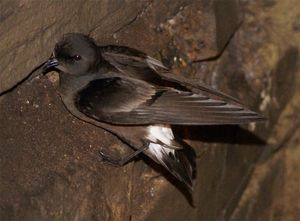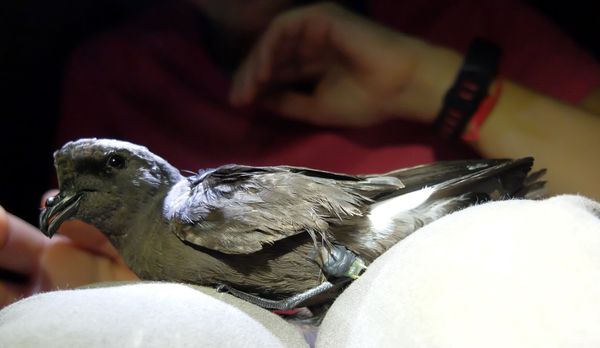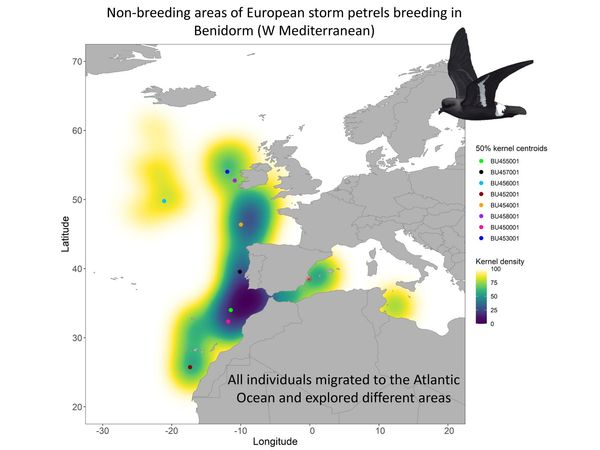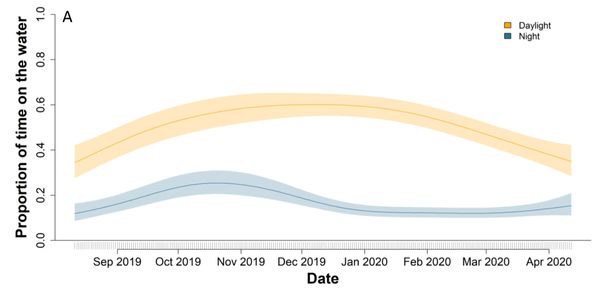 LINKED PAPER
LINKED PAPER
Non-breeding distribution and at-sea activity patterns of the smallest European seabird, the European Storm Petrel (Hydrobates pelagicus). Militão, T., Sanz-Aguilar, A., Rotger, A. & Ramos, R. 2022 Ibis. doi: 10.1111/ibi.13068 VIEW
Animal migration is an incredible, widespread phenomenon that forms a crucial component of the animal life history. Migratory animals move among areas to improve their fitness, by taking advantage of the spatial and/or temporal variation of resources, avoiding predators or finding the most suitable habitats for each stage of their life cycle, but high levels of mortality can occur during the non-breeding period. Despite our knowledge of avian migration, determining the migratory movements of pelagic seabirds can be very challenging, due to their pelagic habits.
This is particularly difficult for the European Storm Petrel (Hydrobates pelagicus), one of the smallest seabird species in the world (~ 28 g). Because of their small size, dark plumage and their pelagic habits, they are difficult to observe at sea, and consequently, we still lack some basic data such as their migratory movements. Nowadays, it is possible to track these small seabirds thanks to the miniaturisation of bio-logging devices called light-level geolocators (geolocators, hereafter, Fig. 1). These devices record the variation of sunlight over time allowing us to infer the location of the bird even when it is in the middle of the ocean.

Figure 1 European Storm Petrel with a small geolocator attached to a metallic ring deployed on its tibia © Raül Ramos.
There are two subspecies of European Storm Petrels which are indistinguishable at sea (Fig. 2): H. p. melitensis which breeds on islands in the Mediterranean Sea and H. p. pelagicus which is more abundant and breeds on several European islands in the Atlantic. Data from the ring recoveries and at-sea sightings from boats suggest that the Atlantic subspecies migrates to South African waters, while stable isotope and geolocation data have so far indicated that the Mediterranean subspecies winter mostly within this sea basin (Martinez et al. 2019, Lago et al. 2019).

Figure 2 European Storm Petrel, the smallest European seabird species. At sea, it is impossible to distinguish both subspecies © Joan Goy.
In our study, we recovered (with downloadable data) 8 of 10 geolocators (of 0.8 g) deployed on European Storm Petrels breeding in Benidorm Island (Western Mediterranean). Surprisingly, all tracked individuals migrated to different areas of the Atlantic Ocean: from the Canary Islands to the south of Iceland (Fig. 3). This result contrasts with the information available until now that most individuals from this subspecies remained within the Mediterranean Sea basin year-round (Lago et al. 2019).

Figure 3 Distribution during the non-breeding season of European Storm Petrels nesting in Benidorm Island. The colour gradient of the background represents the percentage of Utilization Distribution (UD) contours from the kernel density estimation. Colour dots represent the centroids of the 50% UD contour of each individual during the period in which all of them were simultaneously in the Atlantic Ocean. The red star indicates the location of the breeding colony of the tracked birds, the Benidorm Island.
We deployed the geolocators on the tarsus of the birds and not on the back with a harness or sutured as has been done in storm petrels, so far. This methodology allowed us to record complementary data such as conductivity with salt water. Conductivity data give us information about the activity patterns (i.e., when the bird was flying and when it was on the water) of this species during the non-breeding period, which was previously unknown for this species, shedding light on some aspects of the biology of this species. Similar to what occurs during the breeding season, we confirmed that European Storm Petrels are also nocturnal during the non-breeding period. They mainly fly at night and rest on the water surface during daylight hours (Fig. 4). This suggests that European Storm Petrels search for food at night, probably preying on small fish and zooplankton that rise to the surface of the sea only at night.

Figure 4 The daily proportion of time on the water throughout the non-breeding period segregated by daylight (yellow) and night (blue) periods.
Studies like ours are crucial to understand the overlap between areas explored by seabirds and anthropogenic threats they are exposed to and showed that multi-colony studies are needed to understand the drivers of distinct migratory patterns among populations and subspecies.
References
Lago, P., Austad, M. & Metzger, B. 2019. Partial migration in the Mediterranean storm petrel Hydrobates pelagicus melitensis. Marine Ornithology 47: 105-113. VIEW
Martínez, C., Roscales, J.L., Sanz-Aguilar, A. & González-Solís, J. 2019. Inferring the wintering distribution of the Mediterranean populations of European storm-petrels Hydrobates pelagicus melitensis from stable isotope analysis and observational field data. Ardeola 66: 13-32. VIEW
Image credit
Top right: Storm Petrel © Otter CC BY-SA 3.0 Wikimedia Commons.
If you want to write about your research in #theBOUblog, then please see here.



